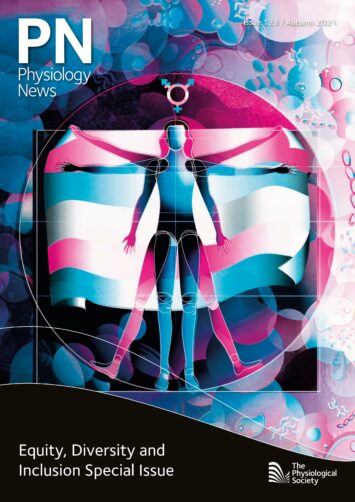
Physiology News Magazine
Toward a strategy for The Society’s Equity, Diversity and Inclusion work
News and Views
Toward a strategy for The Society’s Equity, Diversity and Inclusion work
News and Views
https://doi.org/10.36866/pn.123.5
Professor Raheela Khan, University of Nottingham, UK and Chair of The Society’s Diversity and Inclusion Task Force
My initial curiosity gave way to horror when my son was met by the silence of the hand dryer my (white) husband had just used. It was evident that the dryer, a ubiquitous, inanimate item, would not activate as it was not programmed to ‘sense’ my son’s darker skin tone. A similar problem surfaced early during the pandemic on the poor fitting of face masks for female health professionals working in the NHS. These examples highlight perfectly a widespread lack of biological diversity and inclusivity in product design that standardises for perceived norms of colour (white) and sex (male). In fact, changes in skin tone are one of the current exemplars of understanding the nuances of signs and symptoms in diversifying medical/life sciences education.
In just a few years, equity, diversity and inclusivity have catapulted to the forefront of corporate and institutional change agendas to drive creativity, productivity and improve success measures. In the life sciences including the discipline of physiology, one of the major shifts, identified by initiatives by the Wellcome Trust, has been in recognising the need for an improved, healthier research culture that relies less on metrics, competition and inflexible career pathways and instead promotes a team approach to science, collaboration and a better work-life balance.1 UKRI also stressed the importance of culture and as I write this the Government launched its R&D People and Culture strategy.2
Collectively, these activities and initiatives represent momentous changes to our ways of working. If delivered, this will mean an approach that values and respects individuals and teams, empowering them to flourish while eliminating poor behaviours, bullying and harassment that can undermine professional relationships. The COVID-19 pandemic also raised issues of health inequalities, the disproportionate impact of working from home for female academics and for many of us the direct impact on our students because of the sterile environment of continual, online learning with a loss of real-life lab experience. People-orientated, sustainable cultural change in our organisations is an attainable goal.
Summarising its own commitment to diversity and Inclusion, The Physiological Society, a signatory of the Science Council’s declaration on Diversity, Equality and Inclusion, since 2014, established the D&I taskforce in 2020 (more information via Q&As on p. 38) signalling a new direction to embed D&I more directly into its vision. The Society is also a sponsor of the All-Party Parliamentary Group (APPG) and contributed evidence to the recent Equity in the STEM workforce recommendations (p. 11). Our Support and Inclusion Fund made over 34 awards in 2020 to help members in difficult circumstances. We have made our content in our publications more accessible (p. 14), and Wiley (the publisher of our journals) has introduced a new author name change policy for reasons of gender identity, religion, and relationships (p. 13). We have also doubled our completion rate for reporting from members on their equality, diversity and inclusion (EDI) characteristics. Some of the important events in 2020 from an EDI perspective included the Conference for Black Physiologists, organised by Black in Physiology, Inc. (p. 36), and our conference for early career physiologists called Future Physiology 2021 (p. 35).
In this dedicated Equity, Diversity, and Inclusion issue of Physiology News, we are pleased to include by an article by Javier Bautista in which he describes his journey establishing the LGBTQ+ STEM@UCL network (p. 12). Transgender health is a growing area of medicine but one in which the physiology of transition is scarce. Dr Bastian Greshake Tzovaras, Clara Lehenaff and Dr Mad P Ball provide insight into some of the questions that need addressing especially in relation to the vaginal microbiome (p. 24). The impact of congenital anomalies and sex development are deftly described (Dr Angela Lucas-Herald and Professor Syed Faisal Ahmed). Frailty and ageing (Joseph Taylor, Professor John Gladman, Paul Greenhaff) continue to present physiological challenges illuminated on p. 20. Dr Alastair Noyce and colleagues starkly illustrate the Parkinson’s disease research that is needed in underrepresented (non-European groups), to provide new hope and treatments for affected individuals (p. 32). Finally, Dr Katherine MA Rogers and colleagues present examples of incorporating diversity of real-life patients within cases of the taught physiology curriculum (p. 28).
Going forward, The Society is in the process of producing its roadmap on Diversity and Inclusion by Summer 2022. We plan to engage and consult with members to gather feedback that will ensure that we are truly inclusive and diverse with effective and sustainable change driven by our members.
References and Resources
- Moran H et al. (2020). Understanding research culture: What researchers think about the culture they work in. Wellcome Open Research 5, 201.
- Research and innovation culture. https://www.ukri.org/our-work/supporting-healthy-research-and-innovation-culture/research-and-innovation-culture/
